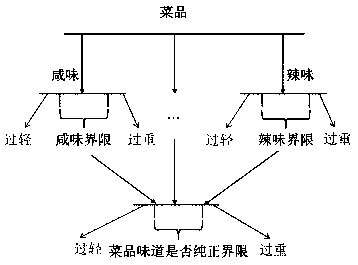A vegetable restoration method based on taste digitization
A technology of taste and dishes, which is applied in the field of dish restoration based on taste digitalization, which can solve the problems of fluctuating dish levels, high cost, and cost increase
- Summary
- Abstract
- Description
- Claims
- Application Information
AI Technical Summary
Problems solved by technology
Method used
Image
Examples
Embodiment 1
[0168] A method of dish restoration based on taste digitalization, such as figure 1 As shown, it mainly includes the following steps:
[0169] Step S101: Obtain a single taste point of the original dish through manual sample statistics; then use manual sample statistics to determine the concentration level of a single taste point;
[0170]Step S102: Obtain the compound taste point of the target dish according to the combination of single taste points in step S101, the formula is as follows:
[0171] w j =K·T'=k 1 t 1 i +k 2 t 2 i +k 3 t 3 i +...+k j t j i
[0172] Among them, k i ∈{0,1}, i=1,2,3...n, j=1,2,3...J, and k i = 0 means to form a compound taste point w j There is no ith single taste point in , k i = 1 means forming a compound taste point w j There is the i-th single taste point in , t j i Corresponding to the concentration level of the jth single taste point, J represents the maximum number of types of compound taste points;
[0173] Step S103:...
Embodiment 2
[0176] This embodiment is optimized on the basis of Embodiment 1, and the artificial sample statistics in step S101 are determined through the F operator semantics and its operation method as follows:
[0177] A ti =|a 1 ti a 2 ti a 3 ti ..........a j ti ], a j ti ∈ {0, 1}, j = 1, 2, 3...n
[0178] in Indicates that the jth person thinks that the dish has t i kind of taste, Indicates that the jth person thinks that the dish does not have a single taste point t i ;and if a ti is less than the set threshold a, it is considered that there is no single taste point t i , otherwise it is considered that there is a single taste point t i .
[0179] On the basis of the basic recipe of the original dish, the single taste point of the original dish is obtained by the method of artificial sample statistics; assuming that there are m+n single taste points; assuming that there are m single taste points determined according to the basic recipe of the dish; x i ∈T, i=1,...
Embodiment 3
[0186] This embodiment is optimized on the basis of Embodiment 1. As shown in Table 1 and Table 2, the concentration level of a single taste point in the step S101 has 5 levels, and there are no, slight , Medium, Yes, and Special; the concentration of the concentration level is the content of the main components in the taste point material; the number of types of single taste points that make up the compound taste point in the step S102 is greater than or equal to 2 and less than or equal to 7.
[0187] It can be known from Table 2 that there are at least 2 individual taste points (such as salty and delicious tastes) and at most 7 (such as strange smells, fish flavors, etc.) that make up the complex taste points. For the sake of memory and understanding later analysis, we sequentially represent the complex taste points—spicy to salty—as W={w 1 ,w 2 ,w 3 ,w 4 ,w 5 ,w 6 ,w 7 ,w 8 ,w 9 ,w 10 ,w 11 ,w 12 ,w 13 ,w 14 ,w 15 ,w 16 ,w 17 ,w 18 ,w 19 ,w 20 ,w 21 ,w ...
PUM
 Login to View More
Login to View More Abstract
Description
Claims
Application Information
 Login to View More
Login to View More - R&D
- Intellectual Property
- Life Sciences
- Materials
- Tech Scout
- Unparalleled Data Quality
- Higher Quality Content
- 60% Fewer Hallucinations
Browse by: Latest US Patents, China's latest patents, Technical Efficacy Thesaurus, Application Domain, Technology Topic, Popular Technical Reports.
© 2025 PatSnap. All rights reserved.Legal|Privacy policy|Modern Slavery Act Transparency Statement|Sitemap|About US| Contact US: help@patsnap.com



